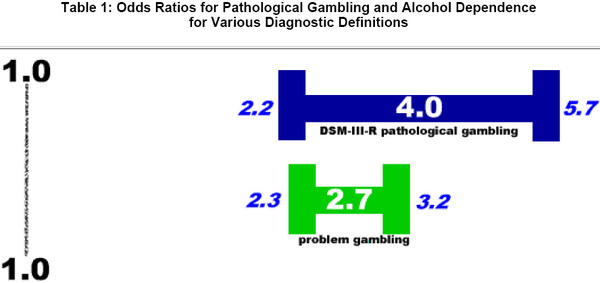Last week’s WAGER [5(28)] reviewed research by Slutske, Eisen, True, Lyons, Goldberg, and Tsuang (2000) [1] that investigated the genetics of pathological gambling using a twin study based on the Vietnam Era Twin Registry. In addition to considering the relationship between zygosity and diagnosis, the authors examine the genetic connection between pathological gambling and alcohol dependence. The methodological nature of their inquiry is beyond the scope of this WAGER, but the findings are interesting and deserve attention.
Among the twins in the sample, subjects diagnosed with alcohol dependence (AD) disorder were significantly more likely to be diagnosed with DSM-III-R pathological gambling (PG) disorder (see table 1). To further validate this association, the authors tested to see if the relationship held true for alternative definitions of compulsive gambling. For the purposes of the present study, "problem gambling" was defined as having 1, 2, or 3 DSM-III-R symptoms of PG or a full diagnosis of PG.
Interpreting the data presented in table 1 requires an understanding of the epidemiological concept of odds ratios. An odds ratio describes the probability of having disorder ‘x’ if you also have disorder ‘y.’ In table 1, subjects with AD are four times more likely to be diagnosed with DSM-III-R PG than subjects without AD. If the odds ratio were 0.25 instead of 4.0, then subjects with AD would be four times less likely to have PG than subjects without AD. If the odds ratio were 1.0 instead of 4.0, then subjects with AD and subjects without AD would be equally likely to have PG. The blue italicized numbers on both sides of the odds ratio indicated the lower and upper bounds of the 95% confidence interval around the probability estimate. Since none of the three confidence intervals contain 1.0, both odds ratios are statistically significant.
The present study supports the relationship between alcohol dependence and gambling disorders. Further research will help determine whether this association holds true for other dependence disorders such as cocaine, tobacco, and stimulant dependence.





